
Wine Culture and Information since 2002 - Volume 22
 Wine Culture and Information since 2002 - Volume 22 |
|
Comparing Torgiano Rosso Riserva and Chianti Classico RiservaTwo red wines usually made from the same grapes, but produced in completely different regions and territories, are among the main representatives of red wines in Umbria and Tuscany |
|
Umbria and Tuscany have in common the border separating them, and there are many cultural, gastronomical and enological differences making unique these two splendid regions of central Italy. Maybe it is the geographic vicinity to make people believe the two regions are pretty the same, but it just takes a look at the views of the respective territories - evocative and tranquil in both cases - to understand their differences. Territories however having common qualities, in particular from an agricultural point of view - in both regions are vines and olive trees to color hills - but each of them keeps its own personality and its own nature. Also from an enological point of view can be found evident differences: whereas in Umbria the production of wine is divided between white and red wines, Tuscany is mainly involved in the production of red wines. In both regions, among the main representatives are found two red wines: Torgiano Rosso Riserva in Umbria, Chianti Classico Riserva in Tuscany.
|
Among the main figures of Umbrian enology, one of the most important ones certainly is Giorgio Lungarotti, not only an important figure for the rebirth and development of Umbrian wine making, but also protagonist - together with other figures - of the rebirth of Italian wines, in Italy and in the world. If today Torgiano is considered one of the most important wine areas of Umbria and of Italy, this mainly was thanks to Giorgio Lungarotti and to his efforts, he believed on the history and the wine making possibilities of this evocative town of central Umbria. Wines of Torgiano conquered their first important goal in 1968, when they reached Denominazione d'Origine Controllata status (Denomination of Controlled Origin), and in 1990, when Torgiano Rosso Riserva was promoted to the level of Denominazione d'Origine Controllata e Garantita (Denomination of Controlled and Guaranteed Origin), the highest level of the Italian quality system. Still today, Torgiano Rosso Riserva represents one of the highest expressions of Umbrian enology. At the base of this wine there is Sangiovese - one of the most common red berried grapes in Umbria - which must be present for at least 70%, whereas the remaining part, in case the producer decides not using 100% Sangiovese, must exclusively be represented by grapes allowed in the territory of the province of Perugia. The remaining part is generally represented by Canaiolo Nero, another red berried grape very common in Umbria. The production of Torgiano Rosso Riserva provides for an aging period of at least three years, of which at least 6 months in bottle. The aging of this wine is generally done both in barrique and in cask. Producers generally prefer to age Torgiano Rosso Riserva in both containers, that is by aging part of the wine in barrique and part in cask. The long aging in wood - which sometimes is longer than three years - gives the wine a higher smoothness and roundness, therefore making less aggressive the typical acidity of Sangiovese.
|
||||||||
|
Chianti Classico certainly is one of the most renowned and famous wines of Tuscany, as well as being one of the wines having the longest documented history of Italy. Chianti Classico has also the record of having the oldest production disciplinary of Italy. On 24th September, 1716, Grand Duke Cosimo III de' Medici issued a law in which was defined the production area of Chianti, as well as founding a special institution of control in order to avoid frauds. Another important date for Chianti Classico was 1840, when Baron Bettino Ricasoli proposed the famous formula for the composition of Chianti: Sangiovese, Canaiolo Nero, Malvasia Bianca and, few years later, Trebbiano Toscano. Bettino Ricasoli also introduced the so called technique of governo alla Toscana, a practice consisting in adding to the wine, at the end of the fermentation, a must produced with dried grapes. This practice - today scarcely adopted - is used to strengthen the body of a wine. The old formula of Ricasoli is today scarcely used, while favoring an almost exclusive use of red berried grapes. Still today Sangiovese represents the main grape of Chianti Classico - present for at least 80% - to which are added, for the remaining part, grapes recommended or authorized in the area, of which Canaiolo Nero and Colorino for autochthonous varieties, Cabernet Sauvignon and Merlot for international varieties. Despite the production disciplinary provides for the use of many grapes, some Chianti Classicos are exclusively produced with Sangiovese, whereas in other cases it is preferred adding to Sangiovese the traditional Canaiolo Nero. Chianti Classico Riserva - the style to which belongs the wine of our comparative tasting - must age, according to the production disciplinary, for at least 24 months, of which at least 3 months in bottle. Also in this case, the aging is done both in barrique and in cask. These techniques are usually used together, that is by aging part of the wine in barrique and part in cask.
|
||||
|
The production disciplinary of the respective wines allow the use of many grape varieties, of which Sangiovese represents, in any case, the main grape. The wines of our comparative tasting are produced with the same grapes, of course produced in their respective areas of origin, and both aged in wood. The first wine of our comparative tasting is Lungarotti's Torgiano Rosso Riserva Rubesco Vigna Monticchio, produced with 70% Sangiovese and 30% Canaiolo Nero, part aged in cask and part in barrique for 12 months, to which follow 3 years of aging in bottle. The second wine of the comparative tasting in Capannelle's Chianti Classico Riserva, mainly produced with Sangiovese and the remaining part with Canaiolo Nero and Colorino, aged for 18 months in cask. The wines will be selected according to the vintages currently commercialized by respective producers and served at the temperature of 18°C (65°F) in two ISO tasting glasses.
|
|
The main grape of Torgiano Rosso Riserva and Chianti Classico is Sangiovese, a grape characterized by a coloring quality which can be defined as ”average”. Canaiolo Nero is traditionally used together with Sangiovese, contributing with a higher roundness, body and a good quantity of color. Canaiolo Nero is a grape of ancient origins - it is believed it existed since Etruscan times - and it is also mentioned in the famous book of Pietro De' Crescenzi Ruralium Commodorum Libri (Profits in Agriculture), written in the beginning of 1300s, times when Canaiolo Nero was considered as a grape having noble wine making qualities. The color of Torgiano Rosso Riserva and Chianti Classico is mainly determined by the qualities of Sangiovese, therefore in these wines can be observed an moderate transparency and intense ruby red color with nuances showing, sometimes and since the moment of commercialization, a garnet red color. The appearance analysis of our comparative tasting starts from Lungarotti's Torgiano Rosso Riserva Rubesco Vigna Monticchio. By holding the glass tilted over a white surface, we will observe the wine at the point of greater thickness - at the base of the glass - where it will be appreciated a moderate transparency and a brilliant and intense ruby red color. Let's now observe the wine at the edge of the glass, at the point of lower thickness: we will observe a garnet red color. Let's now pass to the appearance analysis of the second wine of our comparative tasting: Capannelle's Chianti Classico Riserva. By holding the glass tilted over a white surface, also in this case we will observe a moderate transparency, however lower than the previous wine, and a brilliant and intense ruby red color. In this wine nuances are characterized by a ruby red color.
|
|
Both Torgiano Rosso Riserva and Chianti Classico Riserva are aged for a long time in cask, as well as in barrique, a period in which the wine develops pretty evident and important tertiary aromas. The aging does not however eliminates the olfactory qualities of Sangiovese and Canaiolo Nero grapes which, in both cases, mainly express aromas of plum and black cherry, as well as blueberry, blackberry and raspberry. Among aromas recalling flowers, violet certainly is the most characteristic one, and - marginally - in these wines can also be perceived cyclamen and rose. Time and aging in wood give these wines tertiary aromas generally expressing sensations of vanilla, leather, cocoa, chocolate, tar and licorice, as well as spicy aromas of black pepper, cinnamon, mace, anise and pink pepper. In these wines are also found balsamic aromas such as menthol and eucalyptus. Let's start the analysis of the olfactory profile of the first wine of our comparative tasting: Lungarotti's Torgiano Rosso Riserva Rubesco Vigna Monticchio. By holding the glass in vertical position and without swirling, we will do the first smell in order to evaluate opening aromas. From the glass will be perceived aromas of black cherry, plum and violet, three aromas which are typically found in wines where Sangiovese is the main grape. After having swirled the glass, we will do a second smell in order to complete the olfactory profile of the wine with blueberry, raspberry, blackberry, vanilla, cyclamen, cocoa, tobacco and cinnamon, as well as a pleasing balsamic touch of menthol. Let's now pass to the evaluation of Capannelle's Chianti Classico Riserva. Also in the opening of this wine can be appreciated aromas of black cherry, plum and violet. After having swirled the glass, the aromas of the wine will be completed by blackberry, blueberry, vanilla, tobacco, licorice, cinnamon and chocolate, also in this case followed by balsamic aromas of menthol.
|
|
Sangiovese is a grape producing wines with an appreciable acidity. For this reason, Canaiolo Nero is traditionally used with this grape in order to smooth this characteristic, a common choice before the introduction of Merlot in Italy, today among the main “companions” of Sangiovese. Crispness of Sangiovese is also smoothed by the effects of aging in cask as well as the effects of alcohol. The attack of these wines will therefore be characterized by an appreciable acidity promptly balanced both by roundness given by wood and Canaiolo Nero, as well as by alcohol. The aging in wood also gives a fuller body, a quality increased by the role of Canaiolo Nero. Astringency in these wines is never excessive, both because of the typical quality of Sangiovese as well as because of the effects of the aging in wood, therefore the wines will be well balanced, however expressing a good body and a perceptible astringency. Let's proceed with the evaluation of the first wine of our comparative tasting: Lungarotti's Torgiano Rosso Riserva Rubesco Vigna Monticchio. The attack of the wine expresses an appreciable astringency, followed by a pleasing roundness given by the aging in wood and alcohol. It should also be noticed the pleasing crispness produced by acidity, fundamental for reaching a good balance in this wine. Also the attack of the second wine of the comparative tasting, Capannelle's Chianti Classico Riserva, is characterized by a good astringency - more intense than the previous wine - also in this case balanced both by the good and pleasing roundness, as well as by alcohol. Also in this case acidity contributes to reaching a good balance of the wine. In both wines the correspondence to the mouth is very good, in particular plum and black cherry, as well as persistence.
|
Wines of the Month |
|
|
|
Score legend Prices are to be considered as indicative. Prices may vary according to the country or the shop where wines are bought |
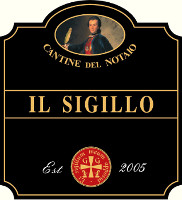
|
|
Aglianico del Vulture Il Sigillo 2005 |
|
| Cantine del Notaio (Basilicata, Italy) | |
| Grapes: Aglianico | |
| Price: € 36.00 | Score: |
| Aglianico del Vulture Il Sigillo shows an intense ruby red color and nuances of ruby red, little transparency. The nose denotes intense, clean, pleasing, refined and elegant aromas which start with hints of plum, blackberry and black cherry followed by aromas of blueberry, violet, vanilla, tobacco, pink pepper, chocolate, mace and menthol. The mouth has good correspondence to the nose, full body, intense flavors, pleasing roundness. The finish is persistent with flavors of blackberry, plum and black cherry. Aglianico del Vulture Il Sigillo ages for 24 months in barrique. | |
| Food Match: Selvaggina, Carne arrosto, Brasati e stufati di carne, Formaggi stagionati | |
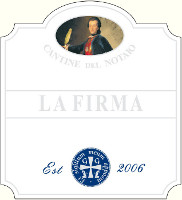
|
|
Aglianico del Vulture La Firma 2006 |
|
| Cantine del Notaio (Basilicata, Italy) | |
| Grapes: Aglianico | |
| Price: € 32.00 | Score: |
| Aglianico del Vulture La Firma shows an intense ruby red color and nuances of ruby red, little transparency. The nose reveals intense, clean, pleasing, refined and elegant aromas that start with hints of blackberry, black cherry and plum followed by aromas of violet, vanilla, blueberry, pink pepper, chocolate, mace, leather, tobacco and menthol. The mouth has good correspondence to the nose, a tannic attack and however balanced by alcohol, full body, intense flavors, pleasing roundness. The finish is very persistent with long flavors of blackberry, black cherry and plum. Aglianico del Vulture La Firma ages for 12 months in cask followed by 12 months of aging in bottle. | |
| Food Match: Game, Roasted meat, Stewed and braised meat, Hard cheese | |
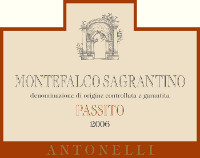
|
|
Sagrantino di Montefalco Passito 2006 |
|
| Antonelli San Marco (Umbria, Italy) | |
| Grapes: Sagrantino | |
| Price: € 25.00 - 375ml | Score: |
| This Sagrantino di Montefalco Passito shows a dark ruby red color and nuances of ruby red, little transparency. The nose reveals intense, clean, pleasing, refined and elegant aromas that start with hints of blackberry, black cherry and violet followed by aromas of plum, blueberry, vanilla, tobacco, chocolate, pink pepper, cinnamon, licorice and menthol. The mouth has good correspondence to the nose, a sweet and tannic attack, however balanced by alcohol, full body, intense flavors, pleasing roundness. The finish is persistent with flavors of blackberry, plum and black cherry. This Sagrantino di Montefalco Passito ages for 12 months in cask followed by 16 months of aging in bottle. | |
| Food Match: Fruit desserts, Confectionery, Hard cheese | |
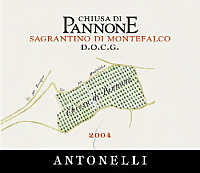
|
|
Sagrantino di Montefalco Chiusa di Pannone 2004 |
|
| Antonelli San Marco (Umbria, Italy) | |
| Grapes: Sagrantino | |
| Price: € 36.00 | Score: |
| Sagrantino di Montefalco Chiusa di Pannone shows an intense ruby red color and nuances of ruby red, little transparency. The nose reveals intense, clean, pleasing, refined and elegant aromas that start with hints of blackberry, plum and black cherry followed by aromas of blueberry, violet, vanilla, tobacco, chocolate, leather, mace, pink pepper and menthol. The mouth has good correspondence to the nose, a tannic attack and however balanced by alcohol, full body, intense flavors, agreeable. The finish is very persistent with long flavors of blackberry, plum and black cherry. Sagrantino di Montefalco Chiusa di Pannone ages for 18 months in cask, 3 months in cement tanks and for 2 years in bottle. | |
| Food Match: Game, Roasted meat, Stewed and braised meat, Hard cheese | |
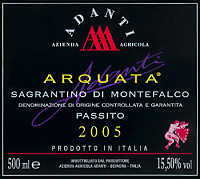
|
|
Sagrantino di Montefalco Passito 2005 |
|
| Adanti (Umbria, Italy) | |
| Grapes: Sagrantino | |
| Price: € 33.00 - 500ml | Score: |
| This Sagrantino di Montefalco Passito shows a deep ruby red color and nuances of garnet red, little transparency. The nose reveals intense, clean, pleasing, refined and elegant aromas that start with hints of blackberry, black cherry and dried violet followed by aromas of plum, blueberry, vanilla, tobacco, chocolate, cinnamon, licorice, lavender, mace, pink pepper and menthol. The mouth has good correspondence to the nose, a sweet and tannic attack, however balanced by alcohol, full body, intense flavors, pleasing roundness. The finish is persistent with flavors of blackberry, black cherry and plum. This Sagrantino di Montefalco Passito ages for 24 months in cask. | |
| Food Match: Hard cheese, Wild berries tarts | |
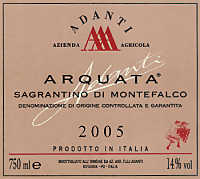
|
|
Sagrantino di Montefalco |
|
| Adanti (Umbria, Italy) | |
| Grapes: Sagrantino | |
| Price: € 23.00 | Score: |
| This Sagrantino di Montefalco shows an intense ruby red color and nuances of ruby red, little transparency. The nose reveals intense, clean, pleasing, refined and elegant aromas which start with hints of blackberry, black cherry and violet followed by aromas of plum, blueberry, vanilla, juniper, chocolate, cinnamon, tobacco, pink pepper, leather and menthol. The mouth has excellent correspondence to the nose, a tannic attack and however balanced by alcohol, full body, intense flavors, agreeable. The finish is very persistent with long flavors of blackberry, black cherry and plum. This Sagrantino di Montefalco ages for 28 months in cask followed by 12 months of aging in bottle. | |
| Food Match: Game, Roasted meat, Stewed and braised meat, Hard cheese | |
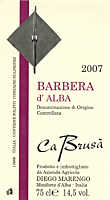
|
|
Barbera d'Alba 2007 |
|
| Ca' Brusà (Piedmont, Italy) | |
| Grapes: Barbera | |
| Price: € 6.50 | Score: |
| This Barbera d'Alba shows an intense ruby red color and nuances of ruby red, little transparency. The nose denotes intense, clean, pleasing and refined aromas that start with hints of cherry, plum and violet followed by aromas of blueberry, chocolate, vanilla and menthol. The mouth has good correspondence to the nose, a tannic attack and however balanced by alcohol, good body, intense flavors, pleasing crispness. The finish is persistent with flavors of cherry, plum and blueberry. This Barbera d'Alba ages for 6 months in barrique followed by 6 months of aging in bottle. | |
| Food Match: Broiled meat and barbecue, Stewed meat with mushrooms, Hard cheese | |
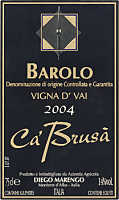
|
|
Barolo Vigna d'Vai 2004 |
|
| Ca' Brusà (Piedmont, Italy) | |
| Grapes: Nebbiolo | |
| Price: € 20.00 | Score: |
| Barolo Vigna d'Vai shows a brilliant ruby red color and nuances of garnet red, moderate transparency. The nose reveals intense, clean, pleasing and refined aromas which start with hints of cherry, plum and violet followed by aromas of vanilla, chocolate, mace, cinnamon, leather and menthol. The mouth has good correspondence to the nose, a tannic attack and however balanced by alcohol, full body, intense flavors, pleasing crispness. The finish is persistent with flavors of cherry and plum. Barolo Vigna d'Vai ages for 15 months in barrique, 10 months in cask and 12 months in bottle. | |
| Food Match: Game, Roasted meat, Stewed and braised meat, Hard cheese | |
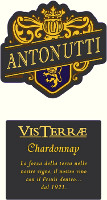
|
|
Friuli Grave Chardonnay Vis Terrae 2007 |
|
| Antonutti (Friuli Venezia Giulia, Italy) | |
| Grapes: Chardonnay | |
| Price: € 12.00 | Score: |
| Friuli Grave Chardonnay Vis Terrae shows a brilliant golden yellow color and nuances of straw yellow, very transparent. The nose reveals intense, clean, pleasing and refined aromas which start with hints of pear, banana and plum followed by aromas of apple, grapefruit, passion fruit, praline and vanilla. The mouth has good correspondence to the nose, a crisp attack and however balanced by alcohol, good body, intense flavors, agreeable. The finish is persistent with flavors of banana, apple and plum. A part of Friuli Grave Chardonnay Vis Terrae ferments and ages in barrique. | |
| Food Match: Stuffed pasta, Stewed fish, Roasted fish | |
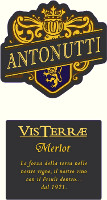
|
|
Friuli Grave Merlot Vis Terrae 2004 |
|
| Antonutti (Friuli Venezia Giulia, Italy) | |
| Grapes: Merlot | |
| Price: € 12.00 | Score: |
| Friuli Grave Merlot Vis Terrae shows an intense ruby red color and nuances of garnet red, little transparency. The nose denotes intense, clean, pleasing and refined aromas which start with hints of black currant, plum and black cherry followed by aromas of blueberry, dried violet, vanilla, tobacco, chocolate and menthol. The mouth has good correspondence to the nose, a tannic attack and however balanced by alcohol, good body, intense flavors, pleasing roundness. The finish is persistent with flavors of black currant, black cherry and plum. Friuli Grave Merlot Vis Terrae ages in barrique for 18 months. | |
| Food Match: Roasted meat, Stewed and braised meat, Hard cheese | |
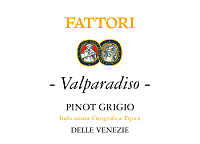
|
|
Pinot Grigio Valparadiso 2009 |
|
| Fattori (Veneto, Italy) | |
| Grapes: Pinot Gris | |
| Price: € 15.00 | Score: |
| Pinot Grigio Valparadiso shows a brilliant greenish yellow color and nuances of greenish yellow, very transparent. The nose denotes intense, clean, pleasing and refined aromas that start with hints of pear, banana and peach followed by aromas of citrus fruits, apple, broom and mineral. The mouth has good correspondence to the nose, a crisp attack and however balanced by alcohol, good body, intense flavors, agreeable. The finish is persistent with flavors of pear, banana and peach. Pinot Grigio Valparadiso ferments in steel tanks and cask. | |
| Food Match: Pasta and risotto with fish and crustaceans, Sauteed fish, Fried fish | |
|
||||||||
|
DiWineTaste Polls
|
| |||||||
Privacy Policy | |||||||


| Copyright © 2002-2024 Antonello Biancalana, DiWineTaste - All rights reserved |
| All rights reserved under international copyright conventions. No part of this publication and of this WEB site may be
reproduced or utilized in any form or by any means, electronic or mechanical, without permission in writing from DiWineTaste. |